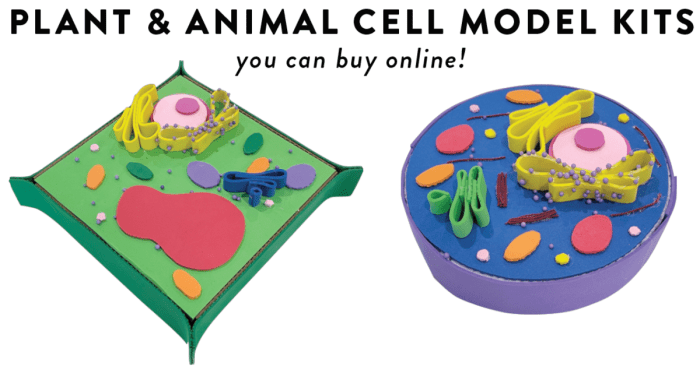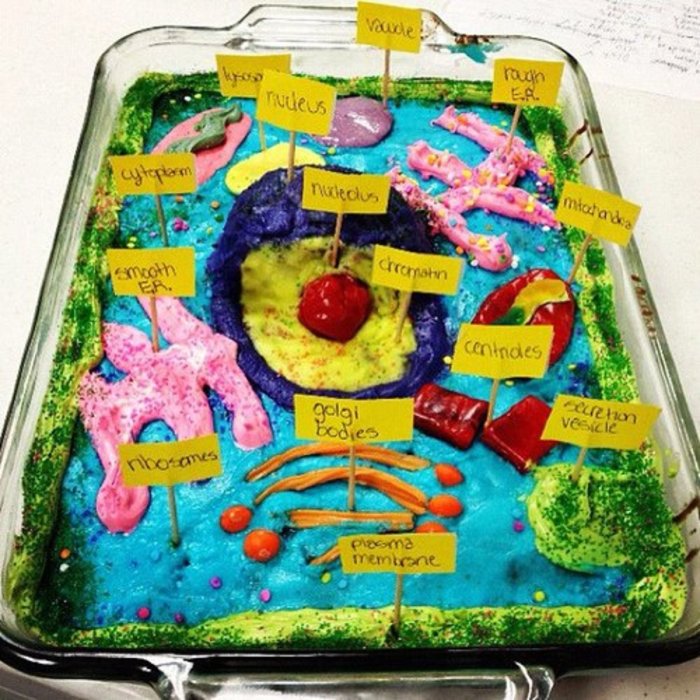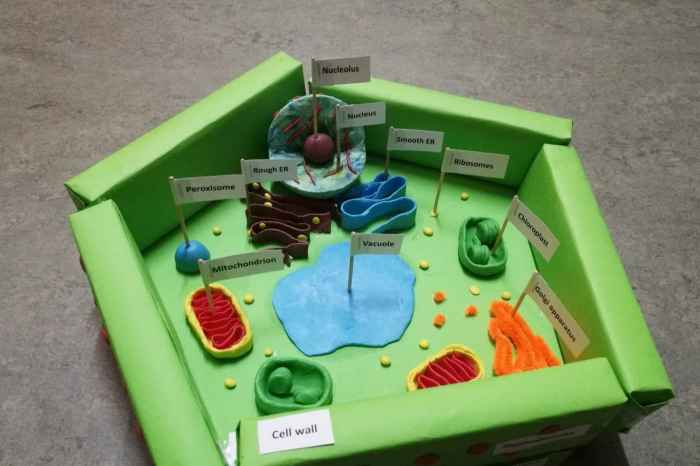Cell model project 3D has become a game-changer in scientific research, allowing us to see inside the intricate world of cells like never before. These 3D models, mimicking the complex structure and function of living tissues, offer a powerful lens for understanding cellular processes, from basic biology to disease development.
Imagine building miniature versions of organs, complete with their own cells, blood vessels, and even the surrounding environment. That’s the magic of 3D cell models. These models are not just static replicas; they are dynamic systems that allow researchers to observe and manipulate cellular behavior in real-time, providing unprecedented insights into the inner workings of life.
Introduction to Cell Model Projects in 3D: Cell Model Project 3d
Cell models are essential tools in scientific research, providing insights into the intricate workings of cells and their interactions within complex biological systems. Traditional 2D cell cultures have been the mainstay of cell research for decades, but they often fail to accurately replicate the three-dimensional environment of living tissues.
This limitation has led to the development of 3D cell models, which offer a more realistic and physiologically relevant platform for studying cellular behavior.
Advantages of 3D Cell Models
3D cell models offer several advantages over their 2D counterparts, making them increasingly popular in various research areas. These advantages include:
- Improved Cell-Cell Interactions:3D models allow cells to interact with each other in a more natural way, mimicking the complex communication networks found in living tissues. This interaction is crucial for understanding cell behavior and function.
- Enhanced Cell Differentiation:The three-dimensional environment of 3D models can promote cell differentiation, allowing researchers to study the development and maturation of various cell types.
- Improved Drug Response:3D models provide a more accurate representation of drug response compared to 2D cultures, which can lead to more effective drug development and personalized medicine.
- Increased Physiological Relevance:3D models better mimic the microenvironment of living tissues, including factors like nutrient gradients, oxygen diffusion, and mechanical stress, providing a more realistic platform for studying cell behavior.
Types of 3D Cell Models, Cell model project 3d
There are several types of 3D cell models used in research, each with its unique advantages and applications:
- Organoids:These are miniature, self-organizing 3D structures that mimic the architecture and function of specific organs. Organoids are often generated from stem cells and can be used to study organ development, disease modeling, and drug testing.
- Spheroids:These are spherical aggregates of cells that form spontaneously in culture. Spheroids are simpler to create than organoids and are often used to study cell-cell interactions and tumor growth.
- Microfluidic Models:These models use microfluidic devices to create controlled microenvironments for cells, allowing researchers to study cell behavior in response to specific stimuli, such as fluid flow, chemical gradients, or mechanical forces.
Design and Development of 3D Cell Models
The design and development of 3D cell models involve a combination of techniques, materials, and considerations to create a suitable environment for cells to grow and function in a three-dimensional manner.
Techniques for Creating 3D Cell Models
Several techniques are employed to create 3D cell models, each with its unique advantages and limitations:
- Bioprinting:This technique uses bioinks, which are cell-laden materials, to create 3D structures with specific architectures. Bioprinting allows for precise control over the placement of cells and materials, making it suitable for creating complex tissue models.
- Microfluidic Fabrication:Microfluidic devices are used to create microenvironments for cells, allowing for controlled manipulation of factors like fluid flow, nutrient gradients, and cell-cell interactions. Microfluidic models are particularly useful for studying cell behavior in response to specific stimuli.
- Scaffold-Based Methods:This approach involves using biocompatible scaffolds, such as hydrogels or polymers, to provide a structural framework for cells to grow and form tissues. Scaffolds can be designed to mimic the extracellular matrix of specific tissues, providing a more natural environment for cells.
Materials for 3D Cell Models
A variety of materials are used to construct 3D cell models, each with its unique properties and suitability for specific applications:
- Hydrogels:These are water-based polymers that can be tailored to mimic the properties of the extracellular matrix. Hydrogels provide a soft and porous environment for cells to grow and interact with their surroundings.
- Polymers:These are synthetic materials that can be used to create scaffolds with specific properties, such as biodegradability, mechanical strength, and biocompatibility. Polymers are often used to create long-lasting 3D models for tissue engineering applications.
- Biocompatible Materials:These materials are designed to be non-toxic and compatible with living cells. Biocompatible materials are essential for creating 3D models that support cell growth and function without adverse effects.
Design Considerations for 3D Cell Models
Several factors need to be considered when designing a 3D cell model to ensure it meets the specific research goals:
- Cell Type:The choice of cell type is crucial for creating a relevant model. The specific cell type will determine the model’s properties and the research questions that can be addressed.
- Model Complexity:The complexity of the model should be tailored to the research question. Simple models, such as spheroids, can be used to study basic cell behavior, while more complex models, like organoids, are needed to investigate organ-specific functions.
- Experimental Goals:The experimental goals should drive the design of the model. For example, if the goal is to study drug response, the model should include relevant cell types and microenvironment factors that influence drug uptake and metabolism.
Applications of 3D Cell Models in Research
3D cell models have revolutionized cell research, providing a more physiologically relevant platform for studying cell behavior, drug development, and disease modeling. Their ability to mimic the complex environment of living tissues has led to significant advances in various research areas.
Studying Cell Behavior
3D cell models allow researchers to study cell behavior in a more realistic context, providing insights into:
- Cell Migration:3D models can be used to study how cells migrate in response to various stimuli, such as growth factors, chemical gradients, and mechanical cues.
- Cell-Cell Interactions:3D models provide a platform for studying how cells communicate and interact with each other, revealing complex signaling pathways and cellular networks.
- Cell Differentiation:3D models can be used to study the differentiation of stem cells into various cell types, providing insights into tissue development and regeneration.
Drug Development
3D cell models are increasingly used in drug development to:
- Screen Drug Candidates:3D models provide a more accurate representation of drug response than 2D cultures, leading to more effective drug discovery and development.
- Predict Drug Toxicity:3D models can be used to assess the potential toxicity of drug candidates before they are tested in humans, reducing the risk of adverse effects.
- Personalize Drug Treatment:3D models can be used to develop personalized drug therapies, tailoring treatment to the specific needs of individual patients.
Disease Modeling

3D cell models are valuable tools for disease modeling, allowing researchers to:
- Study Disease Mechanisms:3D models can be used to study the underlying mechanisms of diseases, such as cancer, neurodegenerative disorders, and infectious diseases.
- Test Potential Therapies:3D models can be used to test the effectiveness of potential therapies for various diseases, identifying promising treatments and optimizing drug regimens.
- Develop Disease-Specific Models:3D models can be created to mimic specific diseases, providing a platform for studying the disease’s progression and developing targeted therapies.
Advantages of 3D Cell Models over 2D Cultures
3D cell models offer several advantages over traditional 2D cell cultures, making them a superior platform for cell research:
- Improved Physiological Relevance:3D models better mimic the microenvironment of living tissues, providing a more realistic platform for studying cell behavior and function.
- Enhanced Cell-Cell Interactions:3D models allow cells to interact with each other in a more natural way, mimicking the complex communication networks found in living tissues.
- Increased Drug Response Accuracy:3D models provide a more accurate representation of drug response compared to 2D cultures, leading to more effective drug development and personalized medicine.
Examples of Research Applications
3D cell models have been used in a wide range of research applications, including:
- Cancer Research:3D models are used to study tumor growth, metastasis, and drug resistance, leading to the development of new cancer therapies.
- Drug Screening:3D models are used to screen drug candidates for various diseases, identifying promising treatments and optimizing drug regimens.
- Tissue Engineering:3D models are used to create tissues and organs for transplantation, addressing the shortage of donor organs and improving patient outcomes.
Challenges and Future Directions in 3D Cell Modeling
Despite their numerous advantages, 3D cell models face several challenges that need to be addressed to fully realize their potential in research and clinical applications.
Limitations and Challenges
- Scalability:Creating 3D models can be time-consuming and expensive, limiting their scalability for large-scale research and clinical applications.
- Cost:The materials and equipment required for 3D cell modeling can be expensive, making it a barrier for some research groups.
- Reproducibility:Reproducibility can be a challenge in 3D cell modeling, as subtle variations in cell culture conditions or model design can lead to different outcomes.
Future Directions

Despite these challenges, the field of 3D cell modeling is rapidly evolving, with several promising future directions:
- Development of More Complex Models:Researchers are working on developing more complex 3D models that mimic the intricate architecture and function of specific organs, providing a more accurate representation of living tissues.
- Integration of Advanced Imaging Techniques:The integration of advanced imaging techniques, such as live-cell microscopy and optical coherence tomography, will allow researchers to visualize and analyze cellular processes in 3D models with unprecedented detail.
- Use of Artificial Intelligence:Artificial intelligence (AI) is being used to analyze data from 3D cell models, identifying patterns and insights that would be difficult to detect manually. AI can help optimize model design, predict drug response, and accelerate the discovery of new therapies.
Comparison of 3D Cell Model Techniques
| Technique | Advantages | Disadvantages | Applications |
|---|---|---|---|
| Bioprinting | Precise control over cell placement and material distribution, allows for complex tissue models | Can be expensive and time-consuming, limited scalability | Tissue engineering, drug screening, disease modeling |
| Microfluidic Fabrication | Allows for controlled manipulation of microenvironment factors, suitable for studying cell behavior in response to specific stimuli | Requires specialized equipment and expertise, limited scalability | Drug screening, cell migration studies, disease modeling |
| Scaffold-Based Methods | Provides a structural framework for cells to grow and form tissues, can mimic the extracellular matrix of specific tissues | Can be difficult to control cell behavior within the scaffold, limited scalability | Tissue engineering, drug delivery, wound healing |
Final Conclusion

The future of cell model project 3D is bright, with the potential to revolutionize drug discovery, disease modeling, and even tissue engineering. As technology continues to advance, we can expect to see even more complex and realistic 3D models that will further unlock the secrets of the cellular world.
Q&A
What are the main advantages of using 3D cell models over traditional 2D cell cultures?
3D cell models offer a more realistic representation of cellular behavior compared to 2D cultures, which are often limited in their ability to capture the complex interactions between cells and their environment. 3D models allow for better understanding of cell signaling, migration, and drug response.
How are 3D cell models used in drug development?
3D cell models provide a more accurate platform for testing drug efficacy and toxicity. They allow researchers to observe how drugs interact with cells and tissues in a more realistic environment, leading to better predictions of drug performance in clinical trials.
What are some of the challenges associated with 3D cell model development?
While 3D cell models offer significant advantages, they also present challenges, including scalability, cost, and reproducibility. Creating and maintaining complex 3D models can be time-consuming and expensive, and ensuring consistency across different models can be difficult.